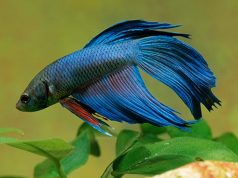Betta Fish Tail Types
Most of the long-finned, amazingly colored betta fish species are mainly a result of the human intervention and successive selection. You can see below, the main betta tail types.
Veil tail: This tail type is the most common and what is usually found in pet stoes. The gene for Veil tail is dominant and is very hard to breed out of a line. The tail is long and thin and usually tapers to a point.
Delta tail: This is where the tail is in the shape of a delta coming off of the caudal peduncle. The spread is measured in degrees and can vary from 50 degrees to 70 degrees.
Super Delta Tail: This is a wider form of the Delta Tail and the the spread of the caudal fin is usually from 70 degrees to 120 degrees.
Ultra Delta Tail: This is an even more glorified version of the Delta Tail. The caudal fin spread is usually between 120 degrees to 160 degrees.
Half Moon: The tail shape is self-explanatory, but for the article’s sake, I will explain. The Half Moon is the caudal fin spreading off of the caudal peduncle at 160 to 180 degrees, and the rays must be of even length. (This rule applies to all forms of the Delta Tail as well). It is hard to dind true Half Moon and they are very expensive. Anything labelled as HM (Half Moon) Genotype usually has a spread of more than 90 degrees. The anal fin on the Half Moon or a Half Moon Genotype is usually extended.
Double Tail: This tail type is a very beautiful one, where the caudal fin is split in the middle, producing two caudal peduncles and what are referred to as tail lobes (fins). A true Double Tail should have an even split right to the body and have two caudal peduncles. The dorsal fin on a Double Tail is extended. Breeding Double Tails to Double Tails is a very risky cross, as this will produce fish with spinal deformities and short bodies due to the twin caudal peduncles. This tail type can sometimes be seen in combination with any of the Delta Tails and Half Moon bettas.
Crowntail: This is the newest and most expensive tail type to date. This type shows the fins rays extending past the webbing of the fins.
SR (Single Ray) is just that–only one ray extends past the webbing.
DR (Double Ray) has each ray dividing into two rays at the webbing.
TR (Triple Ray) is very rare–the rays divide into three at the webbing.
DDR (Double Double Ray) is very expensive, and the rays divide into two at the webbing, then each of those two split rays will divide into two again looking like four rays. The number of rays is counted on the caudal fin only, as the orsal and anal fins only have single rays coming off the webbing. This tail type can be seen in combination with Double Tail and any of the Delta Tails and Half Moon types.
Common Colors
Red: The fins and body are bright red, paling out at the gills and head.
Extended Red: A gloriified type of Red in which the red coloration extends past the gill plates and head.
Royal Blue: The body and fins are a dark, royal blue, ending at the gill plates. The head is usually dark grey-black. This color is very prone to red wash (where red can be seen in the fish, usually the fins.)
Steel blue: The fins and body have a light grey-dark gun-metal blue color ending at the gills and head, which are the ame as the royal blue. This color is also very prone to red wash.
Turquoise: This is a faded bright green throughout the body, ending at the gills and the head is that of a blue betta. (ie: greyish black)
Black/Melano: This is one of the hardest to get in its pure form, and is one of the most desirable colors to breed for in bettas. The whole body and fins are midnight black, and in its pure form, very beautiful. Males of this color are very fertile, but a fertility problem rests in the females. It hasn’t yet been proven, but there is a link between the Melano gene and the females reproductive system that makes them infertile. To get blacks, the best combination is to cross a Melano male to a Steel Blue female. (If she carries the gene for Melano, then you’ve got it made) It is one of the most desired colors to breed and is a challenge to keep the quality. The chances of obtaining or raising a fertile TRUE Melano female are astronomical.
Black Lace: In this type, the black has a more washed-out appearance. These fish are fertile, the black lace look is actually a steel blue coloration that is the result of a steel X black early in its ancestry.
Yellow: This color is a yellow which can range anywhere from an almost clear to a bright butter-yellow covering the whole body and fins.
Cellophane: This fish in its pure form, is a clear-finned pale (very pale) yellow. This is an excellent color to use to increase finnage and body size, as in its purest form, it doesn’t carry any color genes that would affect your reason for using it. (Editor’s note: Possibly amelanistic, and recessive color gene, thus unable to dominate over other colors)
Chocolate: This color is between black and yellow and can be dark brown to a light brown, almost yellow. A very nice color and a somewhat desirable one to breed.
Opaque: This color is the whole fish having a milky opaque color. It comes in White only, and is very desirable in its purest form, with no red wash.
Pastel: This is when the fish has an oily-pastel look to it and it comes in three main colors: Blue, Red, and Green.



